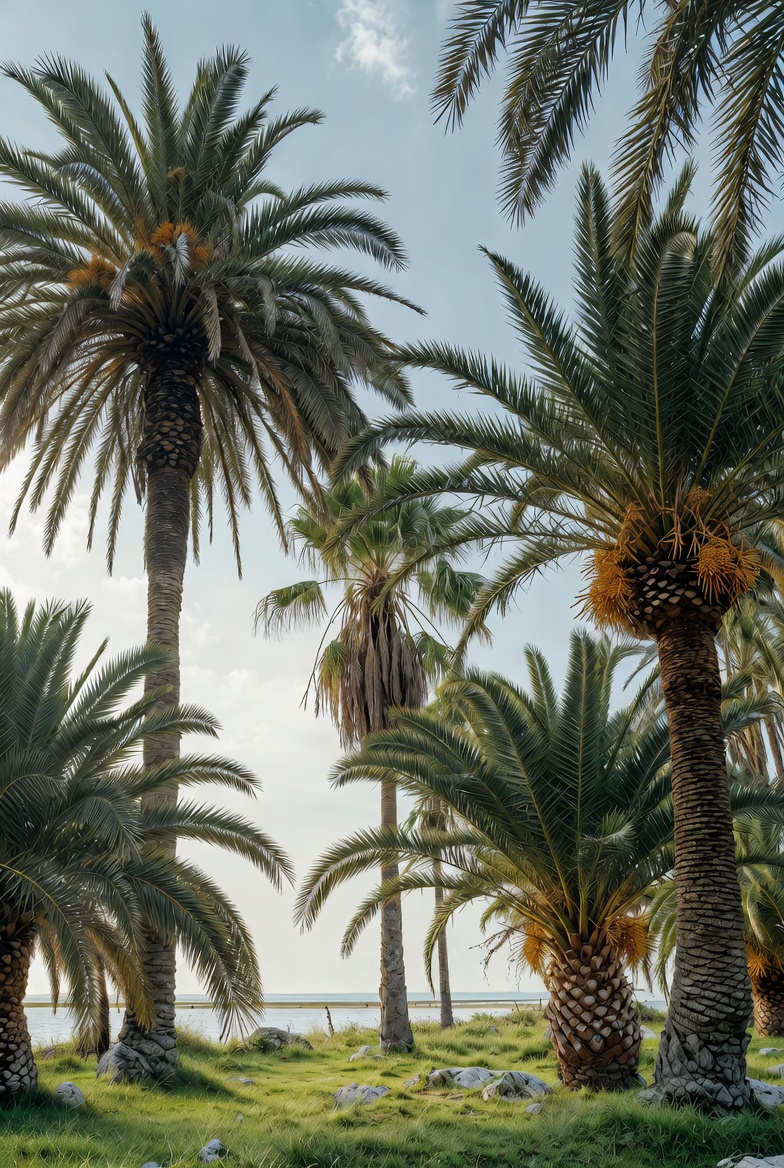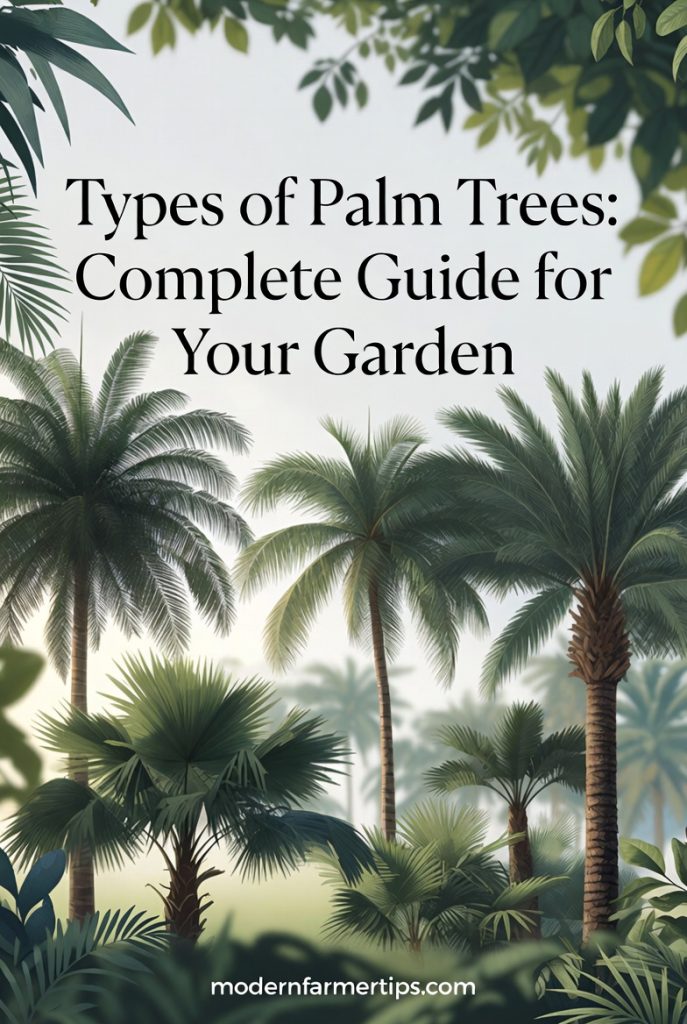Transforming your backyard into a personal oasis often starts with choosing the right plants. For many, nothing says “tropical paradise” quite like the graceful silhouette of a palm tree. With thousands of species available, selecting the right one can feel overwhelming. This ultimate guide to types of palm trees and backyard landscaping will help you navigate the options, ensuring you find the perfect palm to elevate your outdoor space.
From towering giants that create dramatic focal points to smaller varieties that fit neatly into cozy corners, there is a palm tree for every garden. We will explore popular types, offer practical landscaping ideas, and provide essential care tips to help your palms thrive. Let’s dig in and discover how to bring a touch of the tropics to your home.
Understanding Palm Tree Basics

Before diving into specific types, it’s helpful to understand the basic characteristics that differentiate palm trees. They are generally categorized by their fronds (leaves) and their growth habits.
Frond Types: Palmate vs. Pinnate
The leaves of a palm tree, known as fronds, are one of their most defining features. They typically fall into two main categories:
- Palmate Fronds: These leaves are fan-shaped, with segments radiating from a central point, much like the fingers on a hand. Trees with palmate fronds, like the Windmill Palm, often have a more compact and rounded appearance.
- Pinnate Fronds: These are feather-shaped leaves with individual leaflets branching off a central stem. Pinnate fronds, seen on trees like the Queen Palm, create a classic, wispy look that sways beautifully in the breeze.
Growth Habits: Solitary vs. Clustering
Palm trees also differ in how they grow from the ground:
- Solitary Palms: These palms grow with a single, unbranched trunk. They are ideal for creating strong vertical lines or standalone specimen plantings. The Royal Palm is a classic example.
- Clustering Palms: These palms grow multiple trunks from a single base, forming a dense clump. They work well as privacy screens or to fill in larger garden areas. The Areca Palm is a popular clustering variety.
Popular Types of Palm Trees for Your Backyard

With the basics covered, let’s explore some of the best types of palm trees for backyard landscaping. We’ve selected a variety of palms suited for different climates, sizes, and aesthetic preferences.
For Colder Climates: Cold-Hardy Palms
You don’t need to live in the tropics to enjoy palm trees. Several species are surprisingly resilient to cold weather.
- Windmill Palm (Trachycarpus fortunei): Known for its incredible cold tolerance (down to 5°F or -15°C), the Windmill Palm is a top choice for temperate climates. It has distinctive palmate fronds and a slender trunk covered in brown, fibrous material. It grows slowly to about 20-30 feet, making it suitable for smaller yards.
- Pindo Palm (Butia capitata): Also called the Jelly Palm, this tree is admired for its elegant, arching pinnate fronds that curve back toward the trunk. It produces edible, sweet-tart fruits used to make jelly. The Pindo Palm is cold-hardy to about 15°F (-9°C) and reaches a manageable height of 15-20 feet.
For Warm Climates: Tropical Beauties
If you live in a warmer region, your options expand significantly. These palms thrive in heat and humidity.
- Queen Palm (Syagrus romanzoffiana): A fast-growing and majestic palm, the Queen Palm features a smooth, straight trunk and a lush canopy of glossy, pinnate fronds. It can reach heights of 50 feet, making it a stunning choice for larger properties that need a dramatic vertical element.
- Areca Palm (Dypsis lutescens): Often grown as a houseplant, the Areca Palm is also a fantastic outdoor clustering palm for warm, frost-free zones. Its dense, feathery fronds and bamboo-like canes create an excellent privacy screen or a lush, tropical backdrop. It typically grows 15-30 feet tall.
For Small Spaces: Dwarf and Slow-Growing Palms

Limited space doesn’t mean you have to skip the palms. Many smaller varieties are perfect for patios, container gardens, or tight yard corners.
- Pygmy Date Palm (Phoenix roebelenii): This is a popular and elegant dwarf palm. It can be grown with a single or multiple trunks and features fine, feathery fronds. Reaching only 6-10 feet in height, it’s perfect for accent planting near a pool, in a container, or as an understory plant beneath larger trees.
- Sago Palm (Cycas revoluta): While not a true palm (it’s a cycad), the Sago Palm is often used in palm landscaping for its rugged trunk and stiff, dark green fronds. It is extremely slow-growing, rarely exceeding 10 feet over many decades, making it a low-maintenance choice for small gardens.
Backyard Landscaping with Palm Trees
A palm tree can be more than just a plant; it can be the cornerstone of your landscape design. Proper placement and pairing are key to creating a cohesive and beautiful outdoor space.
Creating a Focal Point
A single, striking palm tree can serve as a stunning focal point. A tall, solitary palm like a Royal Palm or Foxtail Palm draws the eye upward and adds a sense of grandeur. Plant it in a central location in your yard or to frame an entryway. Surround the base with low-growing, complementary plants or a bed of decorative river rocks.
Building a Privacy Screen
Clustering palms are nature’s privacy fences. Plant a row of Areca Palms or Bamboo Palms along a property line or around a patio to create a dense, living wall. This not only blocks views but also helps dampen noise and adds a lush, green backdrop to your outdoor living area.
Designing a Tropical Oasis
Combine different types of palm trees to create a layered, jungle-like effect. Use taller palms like the Queen Palm as the canopy layer, medium-sized palms like the Pindo Palm for the mid-layer, and dwarf palms like the Pygmy Date Palm for the understory. Mix in other tropical plants with bold foliage, such as hibiscus, birds of paradise, and elephant ears, to complete the look.
Container Gardening with Palms
Many smaller palms thrive in containers. This is an excellent option for those with patios, balconies, or a desire for flexible design. The Pygmy Date Palm, Sago Palm, and Cat Palm are all great container choices. Using pots allows you to move the plants to protect them from harsh weather or simply rearrange your design whenever you wish.
Palm Tree Care and Maintenance
To keep your palms looking their best, a little care goes a long way. While many palms are low-maintenance, they do have specific needs.
- Sunlight: Most palms prefer full sun, but some, like the Kentia Palm and Cat Palm, tolerate partial shade. Research the specific needs of your chosen variety.
- Watering: Newly planted palms need regular watering to establish their root systems. Once established, many palms are quite drought-tolerant. Water deeply but infrequently, allowing the soil to dry out slightly between waterings.
- Soil: Palms need well-draining soil. If you have heavy clay, amend it with sand and organic compost to improve drainage.
- Fertilizing: Use a slow-release fertilizer specifically formulated for palm trees. These contain the right balance of micronutrients, including magnesium, manganese, and potassium, which are crucial for palm health. Fertilize two to three times during the growing season (spring and summer).
- Pruning: Palms require minimal pruning. Only remove fronds that are completely brown and dead. Never cut green or yellowing fronds, as the tree is still drawing nutrients from them. Cutting the top growth bud (the “heart”) of a solitary palm will kill it.
Frequently Asked Questions (FAQs)
Q1: How fast do palm trees grow?
The growth rate varies greatly by species. Queen Palms are fast growers, potentially adding several feet per year. Others, like the Sago Palm, grow extremely slowly, adding only an inch or two annually.
Q2: Can I grow a palm tree from a coconut?
Yes, you can grow a Coconut Palm (Cocos nucifera) from a store-bought coconut, but only in a very warm, humid climate (USDA zones 10-11). The coconut needs to be fresh and still have its husk.
Q3: Why are the tips of my palm fronds turning brown?
Brown tips are often a sign of underwatering, low humidity, or a buildup of salts from fertilizer. Try watering more deeply and consistently. If you have the palm in a pot, flush the soil with water to wash away excess salts.
Q4: Do all palm trees produce fruit?
Many, but not all, palm trees produce fruit after they flower. Some fruits are edible, like dates from the Date Palm and açaí berries from the Açaí Palm. Others are not edible.
Q5: Is it safe to plant a palm tree near my house?
Yes, palm trees are generally a safe choice to plant near structures. Their root systems are fibrous and not aggressive, so they are unlikely to damage foundations or plumbing. However, consider the mature height and spread of the tree to avoid future conflicts with your roof or power lines.
Final Words
Adding a palm tree to your backyard is an investment in beauty and tranquility. By choosing the right species for your climate and space, you can create a personal retreat that you’ll enjoy for years to come. This ultimate guide to types of palm trees and backyard landscaping has provided the foundation you need to start your project with confidence. Whether you dream of a single, elegant specimen or a dense, tropical jungle, the perfect palm is out there waiting to transform your landscape.





